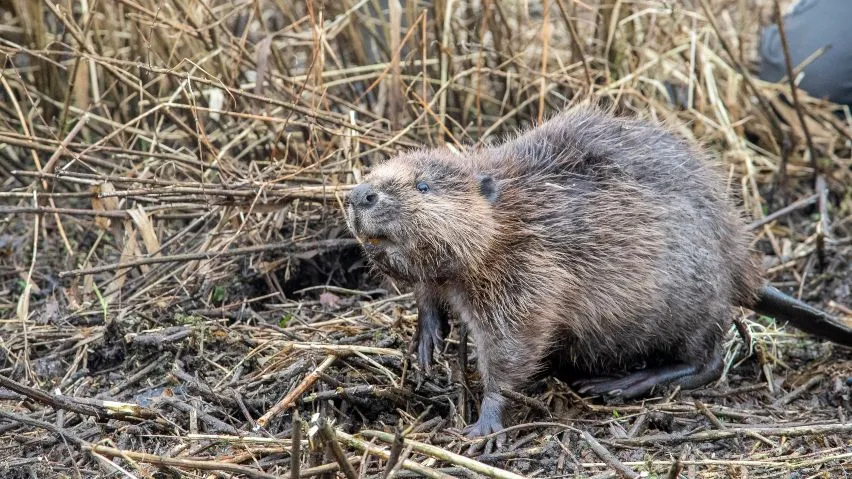Bring back Beavers
Look at a Beaver and tell us it doesn’t make you smile. These slicked-back furry eco-engineers with the big teeth were made extinct in Britain in the 16th century. But they’ve been back in Scotland since 2009 and now, a ground-breaking project led by RSPB Scotland could help speed up their return, giving a huge boost to wildlife, and to the planet.

On this page
Momentous moment
“It didn’t seem real” said RSPB site manager Paula, when she stood metres from Beavers toddling off into the waters of Loch Lomond.
“It was one of those moments when you think, ‘we’ve worked so hard for this, it’s happening, these beavers look happy, they’ve gone off well, everybody’s happy’.
“But it took quite some time to reflect on what that really means because this is a complete once in a lifetime project to be involved with. It’s the first ever mammal translocation in Scotland for the RSPB. It’s a huge deal and really was a lovely moment.”
Ten years in the making
The release of the seven Beavers, two adults and their five young, in January 2023 came after years of planning. When Paula started as site manager at RSPB Loch Lomond a decade ago one of her first meetings was about Beavers possibly returning there.
Paula said: “At that time it was all a pipe dream, with us thinking ‘Who knows when this will happen, when will the legislation be there?’”
A decade on, after a lot of hard work by scientists, policy makers and conservationists, the pipe dream has become a reality. The defining moment was a change in the law in 2021 which allowed the translocation of Beavers from other sites in Scotland. This meant Beavers could be moved from areas where their behaviour was causing problems on farmland, to new more suitable sites where they would’ve once thrived before being driven to extinction.

An opportunity seized
The change in law was a moment RSPB Scotland had been waiting for. The team, who manage the Loch Lomond National Nature Reserve along with the Loch Lomond & the Trossachs National Park Authority and NatureScot, jumped into action and nominated RSPB Loch Lomond as a possible release site.
Paula said: “We’re a National Nature Reserve. It’s kind of a given that this is already a really great place for wildlife, but we want it to be even better. Beavers can help us do that.”
Good quality wetlands which the beavers help build are also really great news for the planet. While degraded wetlands release carbon, well-managed wetlands lock away carbon, which can play a part in fighting the climate emergency.
Recreating lost landscapes
It’s hard to underestimate the positives beavers can make to a wetland.
“Beavers are ecosystem engineers in a way that humans could never replicate,” said Paula.
“Their presence in a wetland will do more to enhance it for wildlife than we could ever hope to do with any amount of man-made intervention.”
How? Well, they improve water quality as beaver ponds prevent sediments and pollutants from flowing downstream. Their natural desire to dam creates shelter and spawning areas for fish. Their handiwork also makes ditches and complicated underwater structures which offer a home for a wide variety of creatures, such as dragonflies and other water-spawning insects. These in turn are eaten by birds, mammals, and amphibians.
Above the water, they create landscapes which have vanished from Britain since the beaver was hunted to extinction.
Paula said: “Scruffy edges with coppiced trees along rivers just don’t exist without Beavers. In the past, these would have been common in the UK and would have hosted a whole variety of different species.”

Out in the wild
Sadly, since release two kits have died after being killed by Otters. While this is an upsetting setback for the beaver family and the team, it’s not uncommon for kits to be killed for food by several creatures, including Otters.
Thankfully the hidden cameras have picked up more promising signs that the other Beavers are settling in and have begun reshaping the landscape at Loch Lomond. There are signs of them gnawing wood and trees and the family have created a new lodge for themselves.
Paula said: “We’ve been seeing them collecting material for dam building, taking advantage of the supplementary food we’re providing but also playing. There have been some signs of courtship between the adult male and female too.”
The future
For the Loch Lomond beaver family, the most important thing at the moment is to minimise disturbance while they settle in. With a few accounts of Beavers elsewhere in the wider Loch Lomond & The Trossachs National Park, the hope is the young kits will spread out once they’re old enough, meet other Beavers and help speed up the colonisation of the area.
But beyond the family, the team behind the translocation hope Loch Lomond will act as a case study on how other Beavers can be translocated around Scotland.
Paula said: “Going forward it’s about giving other landowners the information and the confidence to be able to do this themselves. The tools are now there, the information’s there, the support system’s there and we can share that knowledge with them so that next time a family of beavers need moving, there’s somewhere else for them to go.
“We want this to be something that can be replicated across Scotland.”